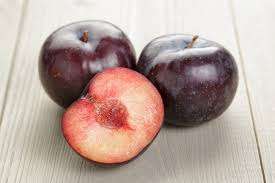Introduction
As pet parents, we often wonder whether the fruits we enjoy are safe to share with our furry friends. Plums, with their juicy sweetness and rich nutrients, may seem like a healthy snack. But when it comes to dogs, not all parts of a plum are safe. While the plum flesh in small amounts may be harmless for some dogs, the pits, stems, leaves, and roots can be toxic and dangerous due to compounds that release cyanide.
This guide covers everything you need to know about feeding plums to dogs, including the benefits, health risks, poisoning symptoms, safe preparation, serving tips, and better alternatives. By the end, you’ll have a clear understanding of whether plums belong in your dog’s bowl.

Are Plums Safe for Dogs?
Learn more about: Can dogs eat peas
- The short answer: Dogs should not eat plums as a regular treat.
- Plum flesh: Small pieces may be safe for some dogs, offering fiber, vitamins, antioxidants, and hydration.
- Plum pits, stems, leaves, and roots: Contain cyanogenic glycosides (like amygdalin and prunasin), which can release hydrogen cyanide — toxic to dogs. They may present a choking danger and could cause an intestinal blockage.
Because the risks far outweigh the benefits, most veterinarians recommend avoiding plums altogether and choosing safer fruits instead.
Nutritional Benefits of Plums (Plum Flesh Only)
If a dog consumes a tiny bite of plum flesh (without pit or skin), here’s what they might get:
- Fiber: Aids in digestion, helps maintain regular bowel movements, and may prevent constipation.
- Vitamin C: Supports immune system health and may improve recovery from illness.
- Vitamin K: Essential for proper blood clotting and supports strong bones.
- Antioxidants: Help combat free radicals, supporting heart health, skin health, and cellular protection.
- Water content: Keeps your pup hydrated, especially during hot weather.
While these nutrients sound beneficial, dogs already get most of what they need from a balanced, species-appropriate diet or high-quality commercial dog food. Fruits should only be considered as occasional treats, not dietary staples.
Why Plums Can Be Dangerous for Dogs
Plum Pits
- Contain cyanide compounds (amygdalin, prunasin) that can release hydrogen cyanide in the stomach.
- Pose a choking risk, especially for small dogs.
- It may lead to an intestinal obstruction in dogs of any size, from small to large breeds.
Plum Skin
- May contain pesticide residue.
- Some dogs may struggle to digest it, which can result in bloating, loose stools, or vomiting.
Stems, Leaves, and Roots
- All parts of the Rosaceae plant family (including plums, cherries, peaches, and apricots) contain cyanogenic glycosides.
- Toxic if ingested, even in small amounts.
High Sugar Content
- Even the plum flesh has a high natural sugar level.
- Regular consumption may lead to weight gain, obesity, or diabetes in dogs.
Symptoms of Plum Poisoning in Dogs
If a dog eats a plum pit, stem, or too much flesh, watch for:
- Vomiting
- Diarrhea
- Drooling
- Lethargy
- Loss of appetite
- Difficulty breathing
- Swollen abdomen (possible intestinal blockage)
- Seizures (in severe cases)
- Collapse
⚠️ Emergency tip: If you suspect your dog has eaten a plum pit or shows signs of plum poisoning, contact your veterinarian or the Pet Poison Helpline immediately.
Can Puppies or Senior Dogs Eat Plums?
- Puppies: Should never be given plums. Their developing digestive systems are more sensitive, and the risks of choking and poisoning are too high.
- Senior dogs: Older dogs may struggle with digestion, making plums risky. In addition, any underlying health conditions (like diabetes or kidney disease) could worsen with plum consumption.
Safe Ways to Offer Plums (If at All)
If you still want to let your dog taste a plum, follow these strict guidelines:
- Remove the pit, stem, leaves, and skin completely.
- Offer only a small piece of flesh, no larger than a pea-sized bite.
- Introduce gradually to avoid digestive upset.
- Monitor your dog closely for allergic reactions or digestive issues.
- Feed occasionally only, never as part of the regular diet.
Even with these precautions, most experts advise choosing safer fruits instead.
Safer Fruit Alternatives for Dogs
Instead of plums, try these dog-friendly fruits:
- Blueberries: Packed with antioxidants, low in calories.
- Apples (without seeds or core): Good source of fiber and vitamins.
- Bananas: Rich in potassium, but feed in moderation due to sugar.
- Watermelon (seedless): Hydrating, low in calories.
- Strawberries: Full of vitamin C and fiber.
These alternatives provide nutritional benefits without the risks associated with plums.
Are Prunes Safe for Dogs?
Prunes are simply dried plums. They contain higher sugar and fiber levels, which can lead to:
- Diarrhea
- Gas
- Bloating
- Stomach pain
They may also contribute to obesity and diabetes if fed regularly. Prunes are not recommended for dogs.
Steps to Take If Your Dog Swallows a Plum Pit
- Do not panic, but act quickly.
- Check your dog’s mouth to see if the pit is still present.
- Contact your vet or reach out to the Pet Poison Helpline right away.
- Keep an eye out for symptoms such as vomiting, diarrhea, excessive drooling, trouble breathing, or lethargy.
- Never attempt to induce vomiting unless instructed by your vet.
Veterinary Advice on Plums for Dogs
Most veterinarians agree that:
- The risks outweigh the benefits when it comes to feeding plums.
- There are plenty of safer fruit alternatives for dogs.
- If you want to add variety, it is better to stick with low-sugar, non-toxic fruits.
Always consult your vet before introducing new foods, especially if your dog has a medical condition, allergies, or is on medication.
FAQs About Dogs and Plums
Yes, a very small piece of plum flesh may not harm your dog, but it is not recommended due to the risks.
Yes. Plum pits contain cyanide compounds, which are toxic and potentially deadly.
No. Prunes are high in sugar and fiber, which can upset your dog’s stomach and lead to diarrhea.
Seek immediate veterinary help. Plum pits can cause both poisoning and intestinal blockage.
Yes! Blueberries, apples (without seeds), watermelon, bananas, and strawberries are safer options.
In severe cases, yes. If untreated, cyanide poisoning can lead to respiratory failure and even death.
Conclusion
Plums may seem like a harmless snack, but when it comes to dogs, they pose more risks than benefits. While the flesh of the fruit in tiny amounts may not be harmful, the pit, skin, stems, and leaves contain toxins that can lead to plum poisoning, choking, or intestinal blockage.
For your dog’s safety, it is wiser to avoid plums and choose dog-friendly fruits such as blueberries, apples, and watermelon. If your dog accidentally eats a plum pit or shows signs of poisoning, seek immediate veterinary care.
By making informed choices, you can protect your dog’s digestive health, heart health, and overall well-being, ensuring they enjoy treats that are both safe and delicious.

